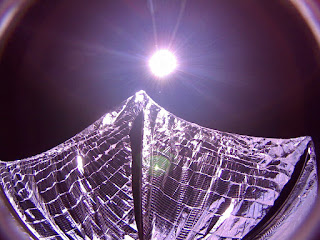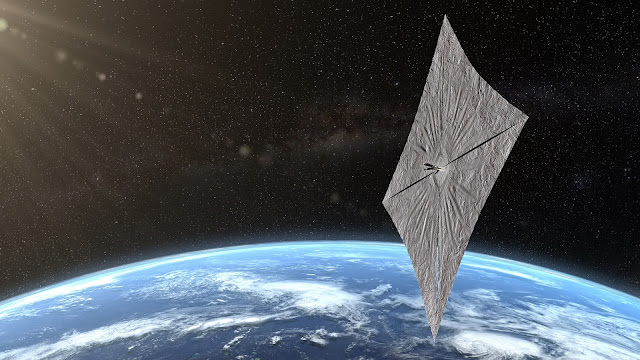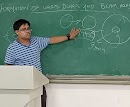Space Exploration
LightSail-2: Miracle of Solar radiation propulsion!!!
Well, once in a while, some amazing humans come forward with their
amazing inventions which have the potential to improve human technology
drastically. LightSail is such a technology!!!
LightSail is a crowdfunded project of the Planetary Society, a
non-profit organization. This project was started to test the solar sailing
technology. This technology primarily focused on CubeSats. They decided to make
this technology for CubeSats because they have revolutionized the space
industry mainly because of tech miniaturization and at the same time carry good
payloads.
The concept of solar sailing was first imagined by Johannes Kepler
over 400 years ago. It was later embraced by famous scientists like Carl Sagan,
Bruce Murray and Louis Friedman.
 |
| Johannes Kepler |
LightSail project consists of two spacecraft namely LightSail-1 and
LightSail-2. This article will be more focussed on LightSail-2 as it’s the most
recent and most influential spacecraft of LightSail project.
But before understanding LightSail-2, firstly, we have to know the
basics of LightSail-1 spacecraft and its mission.
LightSail-1 (formerly LightSail-A) was more like a technological and
engineering sample spacecraft. It didn’t perform solar sailing. It was launched
by Atlas V rocket on 20th May 2015. During its mission, the mission-control
lost the communications with the spacecraft for two times. Later the communications
were re-established and on 10th June 2015 the mission was declared
a success. It re-entered the atmosphere on 14th June 2015.
 |
| LightSail-1's successful deployment |
After the success of LightSail-1, Planetary Society’s next target was LightSail-2 and this time they intended to perform actual solar sailing. After learning from all the mistakes, they did in their first mission, they were ready to launch it. So, it was launched on 25th June 2019 by SpaceX’s Falcon Heavy. LightSail-2 was enclosed within a Georgia Tech student-built spacecraft named as Prox-1. Prox-1 detached from the Falcon heavy into a circular, 720 km high orbit and successfully deployed LightSail-2. This orbit is much higher than that of LightSail-1. After deployment, it opened its hinged solar arrays on 23rd July 2019.
 |
| SpaceX's Falcon Heavy carrying LightSail-2 (source: NASA) |
Once the sail was deployed, the spacecraft was ready to perform its
real task, i.e. solar sailing. The mission objective was to raise its orbit and
for that, the spacecraft had to swing its solar sails into and away from the
sun.
As it’s a solar sail, the craft’s propulsion relies on solar radiation
and not the charged particles of the solar wind. Since it is using solar radiation
for propulsion, the photons of the light coming from the sun exert radiation
pressure on the sail and thus producing acceleration. Acceleration is relative
to sail’s area to its mass. It means that the larger the area and lower the
mass, the acceleration will be better provided that the spacecraft is getting the same amount of solar radiation.
Radiation pressure is the mechanical pressure exerted by the exchange
of momentum between an object (here, sail) and electromagnetic field.
 |
| Orbit raising procedure of LightSail-2 (source: The Planetary Society. Josh Spradling) |
The LightSail-2 sail control algorithm is designed in such a way that
the spacecraft can orient itself and its sail’s edge towards the direction of Sun
when moving towards the Sun and can orient sail’s face towards Sun when moving away
from the Sun. To orient itself, it uses an internal reaction wheel. As we know,
every action has an equal and opposite reaction, so whenever the wheel rotates,
due to the opposite force the spacecraft also orient itself to fix its orientation
accordingly. This strategy was used to increase orbit apogee and they did it
successfully and they announced it on 31st July, 2019. But, as the orbit
perigee decays, it will no longer possible to raise the orbit apogee by using solar
sailing.
 |
| LightSail-2's Succesful deployment |
The project team initially planned to re-enter Earth’s atmosphere
after approximately one year but thankfully an extended mission was approved on
25th Jun, 2020. According to their estimations, LightSail-2’s orbit
decay is around 20-34 meters per day and depends upon the level of active sail
control and with this estimation, it is expected that this craft will be in the
orbit until the first or second half of 2021. Its extended mission objectives may include
the characterization of the orbit decay rates and parallelly imaging operation
will continue during the deorbit phase.
Total Cost of LightSail project (both LightSail-1 and LightSail-2) is
about US $ 7 million and it was paid approximately by 40,000 individuals. It is
including US $ 1.24 million raised from a Kickstarter program.
After, the success of LightSail-2, Planetary Society stated that they currently
have no plans for LightSail-3.
LightSail-2 Specifications:
Dimensions when sails stowed: 10 x 10 x 30 cm
Mass: 5 Kg
Sail Thickness: 4.5 micro metre
Sail material: Mylar, a reflective polyester film
Sail Width: 5.6 m
Sail Boom length: 4 m
Total Sail Area: 32 m^2 or 340 sq ft
Bus (general model of spacecraft): 3U CubeSat
Sail Layout: 4 triangular sails forming a square connected with cobalt
steel booms and booms unwind like tape measures
LightSail has created new possibilities in the field of solar
propulsion. This type of innovations can be used later to develop more complex satellites
which will eventually help us to conquer new heights in space exploration.
In my future posts, I will continue to write about various space exploration articles which will include the contribution of great space agencies like ISRO, NASA, ESA, JAXA etc. along with articles related to Quantum physics, astrophysics and astronomy. If you like my articles then please consider subscribing our newsletter and follow this blog to get the latest updates directly to you
To know basics of quantum world, astronomy and space exploration you can check out my book "Through the wormhole" on amazon kindle.
Thanks for Reading!!!
Check out my other blog posts!!!
Don't forget to share this post in your social media handles to enrich everyone's knowledge!!!
You can directly talk with me on Instagram
To meet more physics Enthusiasts please join our Facebook Page
Also for latest updates of my posts join me on Twitter
See you Again!!!!!
-Ratnadeep Das Choudhury
Founder and writer of The Dynamic Frequency













0 Comments